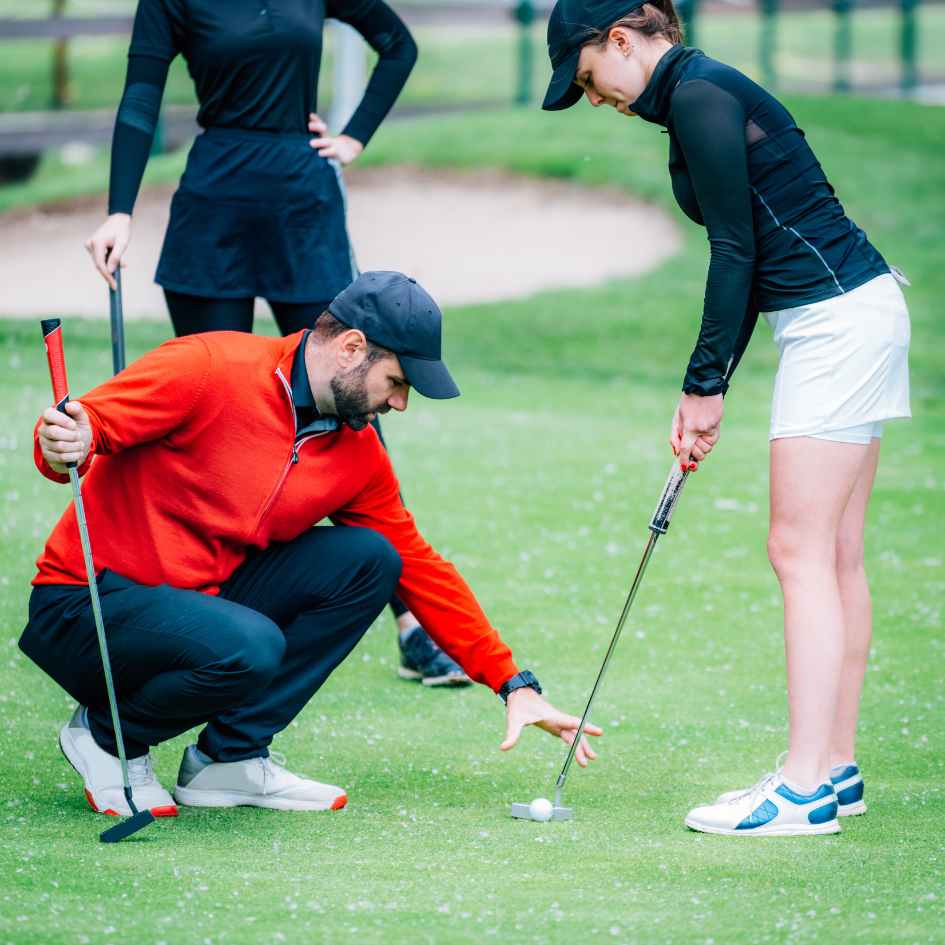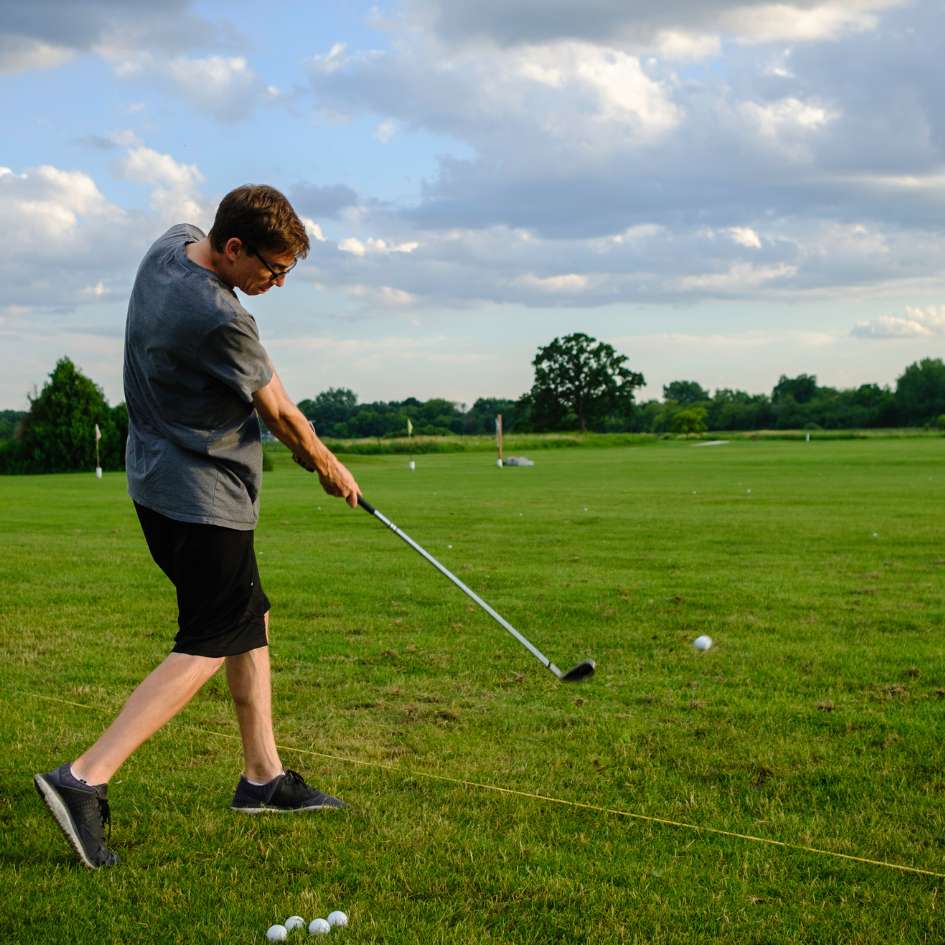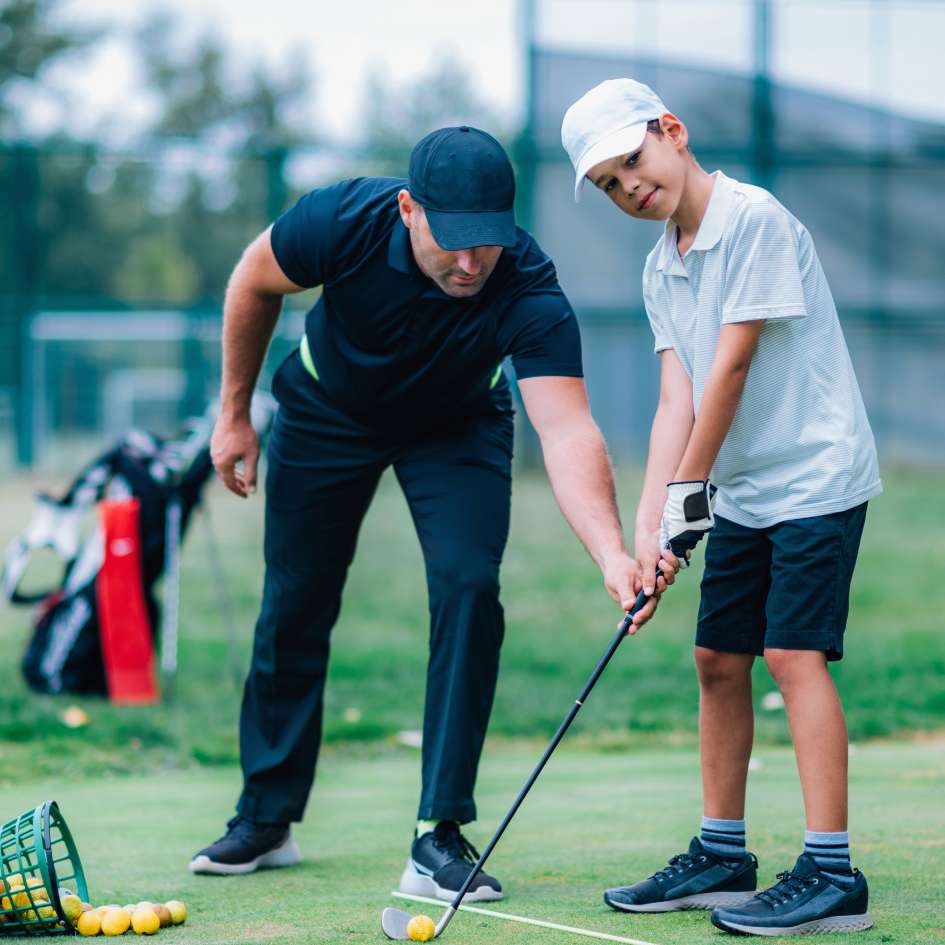
Golf Swing for Beginners – A Comprehensive Guide
Golf Swing for Beginners
A Comprehensive Guide to Master the Golf Swing For Beginners
Embarking on your golf journey? Perfecting your golf swing is fundamental, especially for beginners. In this guide, we’ll explore the intricacies of the golf swing, drawing inspiration from principles that enhance balance and consistency. Let’s break it down into crucial components, from the setup to the follow-through, ensuring you build a solid foundation for your swing.
Setup for Success
Proper Alignment: Ensure your feet, hips, and shoulders are parallel to the target line. This alignment sets the stage for a consistent and accurate swing.
Weight Distribution: Embrace a forward weight principle. Shift your weight towards the lead foot, maintaining about 55-60% of your weight on that side for better control.
Ball Position: Place the ball slightly forward in your stance, opposite the lead heel. This encourages a sweeping motion through impact.
Arm Position: Keep your arms relaxed and extended. A slight bend in your elbows promotes a wide takeaway, contributing to a more powerful swing.

Building a Solid Backswing

Connected Takeaway: Initiate your backswing by moving your entire body together. Emphasize a connected, one-piece takeaway.
Maintaining Spine Angle: Resist the urge to lift your upper body excessively. Keep your spine angle constant to promote a consistent and repeatable swing.
Full Shoulder Turn: Rotate your shoulders fully to achieve a complete backswing. This turn sets the stage for generating power on the downswing.
Lead Arm Depth: Focus on maintaining depth with your lead arm. Keep the lead arm close to the chest, promoting a compact and controlled backswing.
Executing the Downswing
Weight Transfer: Emphasize a lateral shift of your weight towards the lead foot. This forward weight transfer maximizes the power and consistency of your downswing.
Hip Rotation: Initiate your downswing with a rotation of the hips. This movement creates a dynamic sequence, transferring energy from the lower body to the upper body.
Maintaining Spine Tilt: Keep the spine tilted away from the target as you initiate the downswing. This maintains the inside-out swing path crucial for accuracy.
Dynamic Release: Allow for a natural release of the clubhead through impact. Promote a full extension of the arms for a powerful and controlled strike.

Picture-Perfect Follow-Through

Full Extension: Aim for a full extension of the arms post-impact. This extension maximizes clubhead speed and contributes to a fluid follow-through.
Right Heel Lift: Experience a lift of the right heel (for a right-handed player) during the follow-through. Facilitate a complete rotation of the body for a balanced finish.
Posture Maintenance: Maintain a balanced and athletic posture as you complete your swing. A controlled finish reflects the overall stability and control of your swing.
Head Position: Keep your head steady and facing the target throughout the follow-through. Stability promotes consistency and accuracy in your shots.
Want a deeper understadning of the golf swing? ⛳️
Ready to Take the Next Step? ⛳️
If you’re eager to dive deeper into golf’s intriguing world and master the ins and outs of the game, look no further than our “Golf For Beginners – The Ultimate Starter Guide.” Whether you’re a newbie or just brushing up on your skills, this online course has something for everyone.
⛳️ Discover the Ultimate Golf Starter Guide Right Here ⛳️
Your Journey to a Perfected Golf Swing
Congratulations! You’ve navigated through our comprehensive guide to the golf swing for beginners, inspired by principles that enhance balance and consistency. As you practice these principles, remember that mastery comes with consistent effort and dedication. Golf For Beginners Academy is here to support you every step of the way. Embrace these principles, refine your swing, and enjoy the journey to becoming a skilled and confident golfer. Happy swinging!
If you want more detailed help with you game of golf, and specifically about the short game of golf, our partner-portal called World Of Short Game deliver great content for all short game related topics. Click here to visit World Of Short Game.
And if you live in Denmark, never hesitated to reach out to Danish Golf Academy for help with any part of your game.

9 Essential Golf Putting Tips for Beginners
9 Essential Golf Putting Tips for Beginners
Perfecting Your Putting as a Beginner
Welcome to Golf For Beginners Academy, where we guide novice players through the basics of golf. Today, we’re focusing on an integral aspect of the game – putting. For beginners, mastering the putt is key to lowering scores and enjoying the game to the fullest. Let’s delve into essential golf putting tips tailored just for you.
Golf Putting Tips for Beginners
Grip and Stance: Start with a comfortable grip, neither too tight nor too loose. Adopt a shoulder-width stance for stability. This sets the foundation for a controlled and consistent putting stroke.
Eye Alignment: Ensure your eyes are directly over the ball. This alignment enhances your perception of the putting line and helps you visualize the correct path to the hole.
Smooth Putting Stroke: Develop a smooth, pendulum-like putting stroke. Avoid unnecessary wrist movements and let the shoulders control the motion. A steady stroke promotes accuracy and distance control.
Distance Control: Mastering distance control is crucial. Spend time practicing putts of various lengths to develop a feel for the required strength. Consistent distance control is a game-changer on the green.
Read the Green: Analyze the slope and break of the green before making your putt. Look for subtle undulations that can influence the ball’s path. Reading the green is a skill that improves with practice and observation.
Practice Putting Drills: Incorporate putting drills into your practice routine. Focus on short putts to build confidence and gradually extend the distance as your skills improve. Consistent practice hones your putting prowess. Check out this article for our favorite putting-drills for beginners!
Putter Choice: Experiment with different putters to find one that feels comfortable for you. The right putter can enhance your control and confidence on the green. Consider seeking advice from a golf professional to find the perfect fit.
Maintain a Routine: Develop a pre-putt routine to create consistency in your setup and stroke. This routine could include a few practice swings, checking the line, and aligning the putter face to your intended target.
Stay Calm Under Pressure: Putting often determines the outcome of a hole. Practice keeping a calm mindset, especially when facing pressure situations. Relax, trust your skills, and execute your stroke with confidence.
Listen to a deeper explanation on our Podcast!
Time to get to work!
Congratulations! You’re now equipped with essential golf putting tips designed specifically for beginners. Put these insights into practice, and watch as your putting skills improve, contributing to a more enjoyable and successful golfing experience. Stay tuned to Golf For Beginners Academy for more valuable tips to enhance your game. Happy putting!
Ready to become a better golfer? ⛳️
You’ve learned about the putting game of golf. If you’re eager to dive deeper into golf’s intriguing world and master the ins and outs of the game, look no further than our “Golf For Beginners – The Ultimate Starter Guide.” Whether you’re a newbie or just brushing up on your skills, this online course has something for everyone.
⛳️ Discover the Ultimate Golf Starter Guide Right Here ⛳️
Did You Like These 9 Essential Golf Putting Tips for Beginners?
If you want more detailed help with you game of golf, and specifically about the short game of golf, our partner-portal called World Of Short Game deliver great content for all short game related topics. Click here to visit World Of Short Game.
And if you live in Denmark, never hesitated to reach out to Danish Golf Academy for help with any part of your game.

How do I improve my golf swing? 25 Checkpoints
How do I improve my golf swing? 25 Checkpoints
Strategies on How to Improve Your Golf Swing
Welcome to Golf For Beginners Academy, where we unravel the mysteries of refining your golf swing. If you find yourself pondering the question, “How do I improve my golf swing?” – you’re in the right place. In this detailed guide, we’ll delve into a variety of strategies to enhance your swing and, consequently, elevate your overall golf performance.
Understanding the Mechanics: The Foundation of Improvement
To improve your golf swing, it’s essential to understand the foundational mechanics that contribute to a successful and consistent motion.
Grip Refinement: Start by evaluating and refining your grip. A proper grip establishes control and allows for a more natural release of the clubhead.
Posture Assessment: Analyze your posture during setup. Ensure a balanced and athletic stance, promoting better weight distribution and stability throughout the swing.
Alignment Precision: Check your alignment regularly. Misalignment can lead to inaccurate shots, so ensuring proper alignment is a fundamental step in refining your golf swing.
Mastering the Takeaway: Focus on a smooth and controlled takeaway. A well-executed takeaway sets the stage for the entire swing sequence.
Balancing Weight Transfer: Practice a seamless weight transfer during your swing. A balanced shift from backswing to downswing contributes to power and accuracy.

Addressing Common Swing Flaws
Identifying and addressing common swing flaws is crucial for continuous improvement.

Slice Correction: If you’re struggling with a slice, analyze your clubface angle and swing path. Adjustments to your grip and swing plane can help correct this common issue.
Hook Reduction: For golfers battling a hook, focus on grip adjustments and swing path correction. A smoother release and controlled follow-through can help reduce unwanted hooks.
Consistent Tempo: Maintain a consistent tempo throughout your swing. Sudden changes in speed can lead to inconsistency, so practice a rhythmic and controlled motion.
Overcoming Tension: Eliminate tension from your swing by staying relaxed. Tension can hinder flexibility and fluidity, impacting the overall quality of your swing.
Enhancing Clubhead Speed: Work on increasing clubhead speed gradually. A faster clubhead contributes to greater distance, but it should be achieved through proper mechanics, not excessive force
Drills and Exercises for Improvement
Incorporate specific drills and exercises into your practice routine to target key aspects of your swing.
Swing Plane Drills: Practice swinging along the correct plane using alignment sticks or training aids. This helps ingrain the proper path for a more consistent swing.
Weight Transfer Exercises: Incorporate weight transfer exercises into your fitness routine. Strengthening key muscles contributes to a more controlled weight shift during the swing.
Balance and Stability Workouts: Improve your balance and stability with targeted exercises. A stable base enhances overall control and prevents unnecessary compensations in your swing.
Clubhead Awareness Drills: Develop a heightened awareness of your clubhead’s position throughout the swing. This awareness promotes a more deliberate and controlled swing.
Mirror Practice Sessions: Utilize mirror practice sessions to observe your swing mechanics. Visual feedback is invaluable for identifying areas that need adjustment.

Mental Approaches to Swing Improvement
The mental aspect of the game plays a significant role in swing improvement. Adopt these strategies for a positive mindset.

Visualization Techniques: Visualize successful swings in your mind before each shot. Positive visualization enhances confidence and aids in replicating desired swing patterns.
Focused Practice Sessions: Approach your practice sessions with a specific focus. Target one aspect of your swing at a time, dedicating focused effort to each improvement area.
Patience and Persistence: Understand that swing improvement takes time. Be patient with the process and celebrate small victories along the way.
Positive Self-Talk: Cultivate a habit of positive self-talk on the course. Encourage yourself, even in challenging moments, and maintain a constructive internal dialogue.
Learn from Mistakes: View mistakes as learning opportunities. Analyze each swing, identify areas for improvement, and use setbacks as stepping stones to a better golf swing.
Seeking Professional Guidance
Consider enlisting the expertise of a professional golf instructor for personalized guidance.
Private Lessons: Private lessons provide one-on-one attention, allowing the instructor to assess your unique swing characteristics and tailor recommendations for improvement.
Video Analysis: Utilize video analysis during lessons to visually dissect your swing. Seeing your swing from different angles helps identify areas that require adjustment.
Customized Practice Plans: Work with an instructor to develop customized practice plans. Targeted drills and exercises can accelerate the improvement process under professional guidance.
Regular Check-Ins: Schedule regular check-ins with your instructor to track progress. Consistent feedback and adjustments contribute to ongoing improvement.
Utilizing Golf Technology: Leverage golf technology, such as swing analysis apps and launch monitors, during lessons. These tools provide valuable data for pinpointing areas of improvement.

Ready to Take the Next Step? ⛳️
If you’re eager to dive deeper into golf’s intriguing world and master the ins and outs of the game, look no further than our “Golf For Beginners – The Ultimate Starter Guide.” Whether you’re a newbie or just brushing up on your skills, this online course has something for everyone.
⛳️ Discover the Ultimate Golf Starter Guide Right Here ⛳️
Conclusion: Your Journey to Swing Mastery
Congratulations! You’ve navigated through our comprehensive guide on how to improve your golf swing. Whether you’re a novice or seasoned player, continuous improvement is a shared goal in the golfing community. Apply these strategies, stay dedicated to your practice, and revel in the evolving experience of becoming a skilled and confident golfer. Golf For Beginners Academy is here to support you every step of the way. Happy swinging!

Swing Smarter, Not Harder: Your Guide to Avoiding Topped Shots
Avoiding Topped Shots
Welcome to the Golf For Beginners Academy, where we’re on a mission to help you turn your golf game from frustrating to fantastic! If you’ve ever found yourself topping the ball and sending it embarrassingly low and off-target, you’re not alone. But fear not, we’ve got the insider tips to help you get your swing back on track. In this post, we’ll dive into the reasons behind topping the ball and share some essential insights to correct your swing. Let’s get started on the journey to more successful shots!
Why Do You Keep Topping the Ball?
Topping the golf ball happens when your clubface doesn’t make clean contact with the ball, resulting in a weak, low, and inaccurate shot. So, why does this happen? Let’s break it down.
The Shoulder Angle Dilemma
In your golf swing, the position of your shoulders plays a crucial role. Ideally, your shoulders should rotate on the same angle as your spine during the backswing. However, a common mistake, especially among beginners, is the left shoulder rotating more upwards instead of downwards. This causes your swing to go awry.
From a front view, this error looks like your left shoulder is lifting, rather than rotating down towards the ground. When your shoulder moves upward, it disrupts the desired upper body tilt of your swing, causing your head to rise excessively.
The Chain Reaction
Now, here’s the domino effect: as your head moves up, the golf club follows suit, moving up over the ground. This is precisely why you keep topping the ball. The clubface loses its ability to strike the ball cleanly, leading to those frustrating, scuffed shots.
How to Fix It: Swing Tips
Now that we’ve identified the problem, let’s talk solutions. Here are some tips to help you correct your swing and stop topping the ball:
Shoulder Awareness: During your backswing, focus on keeping your left shoulder rotating downward along your spine’s angle. This will help you maintain a steeper shoulder plane.
Practice Slow and Steady: Slow down your swing and practice it in slow motion. This will help you build muscle memory for the correct shoulder movement.
Head Position: Pay attention to your head. Keep it steady and avoid excessive movement. Imagine your head as the anchor point for your swing.
Professional Guidance: Consider taking lessons from a golf instructor who can provide personalized guidance to fix your swing mechanics.
Ready to Take the Plunge? ⛳️
If you’re eager to dive deeper into golf’s intriguing world and master the ins and outs of the game, look no further than our “Golf For Beginners – The Ultimate Starter Guide.” Whether you’re a newbie or just brushing up on your skills, this online course has something for everyone.
⛳️ Discover the Ultimate Golf Starter Guide Right Here ⛳️
Swing Smart, Swing High
Topping the golf ball can be frustrating, but with the right adjustments and plenty of practice, you can overcome this common issue. Remember, Rome wasn’t built in a day, and neither is a perfect golf swing. Stay patient, stay focused, and soon enough, you’ll be sending those balls soaring high and true. Your journey to becoming a better golfer starts now!

Sink More Putts with These Fun Putting Drills for Beginners
Fun Putting Drills for Beginners
Sink More Putts with These 5 Favorite Fun Putting Drills for Beginners
Fun Putting Drills for Beginners – Welcome to the Golf For Beginners Academy, where we’re all about helping you kickstart your golf journey with a big swing (or should we say, putt?). If you’re new to the world of golf or looking to up your putting game, you’ve come to the right place! In this post, we’re going to introduce you to five super-fun putting drills that will not only sharpen your skills but also have you grinning from ear to ear on the greens. So, grab your putter and let’s roll!
1. Clock Drill: "Time" to Get Better at Putting!
Imagine turning your golf ball into the minute hand of a clock. Intrigued? Set up a circle of tees around the hole, mimicking the hours on a clock face. Start at 3 feet and make your way around, sinking putts from each “hour.” As you become a putting pro, increase the distance. You’ll be surprised how addictive it is to watch your game “tick” forward!
Here is what to do:
- Place six tees in a circle around the hole, representing the numbers on a clock (12, 3, 6, 9, and the points in between).
- Start at 3 feet from the hole and attempt to sink putts from each “hour” on the clock.
- Gradually increase the distance to the hole as you become more comfortable with the drill.
2. Gate Drill: Paving the Way to Precision!
Picture this: a gateway to putting perfection. Set up two tees or alignment sticks just wider than your putter head about 3-4 feet from the hole. Your mission? Putt through the “gate” without touching the tees. It’s like threading a needle with your putter, and when you master it, your accuracy will be off the charts.
Here is what to do:
- Set up two tees or alignment sticks just wider than the width of your putter head about 3-4 feet from the hole.
- Practice putting through the “gate” without touching the tees.
- This drill helps improve your strikepoint and accuracy.
3. Lag Putting Game: Where Distance Meets Precision!
Ever heard the saying, “Drive for show, putt for dough”? This game is all about the dough! Place balls at varying distances from the hole and focus on getting them to stop within a 3-foot radius. Master this, and you’ll have the perfect recipe for consistent, confidence-boosting putts.
Here is what to do:
- Place several golf balls at various distances from the hole, ranging from short to long putts (e.g., 3 feet, 6 feet, 10 feet, 15 feet).
- Focus on making each putt stop within a 3-foot radius around the hole.
- This game helps develop your distance control on putts.
4. Two-Ball Challenge: Double the Fun, Double the Skill!
Who says golf can’t be a party? Grab two golf balls and putt them simultaneously toward your target. The challenge? Make both putts or get them as close as possible. It’s like patting your head and rubbing your tummy, but for golfers. This drill is a blast and boosts your consistency and confidence in your putting stroke.
Here is what to do:
- Take two golf balls and putt them simultaneously toward the same target.
- The goal is to make both putts or get both balls as close to the hole as possible.
- This drill helps improve consistency and confidence in your putting stroke.
5. Putting Horse: A Fun Game with a Dash of Competition!
Ready to add some friendly competition to your practice? Enter “Putting Horse,” inspired by the classic basketball game of HORSE. Challenge a friend to replicate your chosen putt, and if they miss, they get a letter (starting with “H”). Keep going until one of you spells out “HORSE.” Loser buys the post-game snacks!
Here is what to do:
- Similar to the basketball game of HORSE, you can play a putting game with a partner.
- One player selects a putt (e.g., a 10-foot downhill break from left to right).
- If they make the putt, the other player has to replicate it. If they miss, they receive a letter (starting with “H”).
- Continue until one player spells out “HORSE.”
- This game adds an element of pressure and fun competition to your putting practice.
Ready to Take the Plunge? ⛳️
If you’re eager to dive deeper into golf’s intriguing world and master the ins and outs of the game, look no further than our “Golf For Beginners – The Ultimate Starter Guide.” Whether you’re a newbie or just brushing up on your skills, this online course has something for everyone.
⛳️ Discover the Ultimate Golf Starter Guide Right Here ⛳️
Conclusion on Fun Putting Drills for Beginners
Practice doesn’t have to be dull, and improving your putting skills can be a ton of fun! These five putting drills will not only help you become a better golfer but also make your time on the greens an absolute delight. So, whether you’re dreaming of sinking that game-winning putt or just enjoying a sunny day on the golf course, these drills are your ticket to putting success. Happy putting, golfers!
Did you like "Fun Putting Drills for Beginners"?
If you want more detailed help with you game of golf, and specifically about the short game of golf, our partner-portal called World Of Short Game deliver great content for all short game related topics. Click here to visit World Of Short Game.
And if you live in Denmark, never hesitated to reach out to Danish Golf Academy for help with any part of your game.
Recent Comments
Copyright @ 2024 - Golf For Beginners Academy

